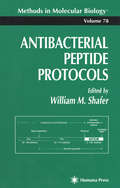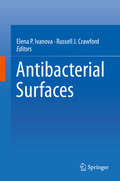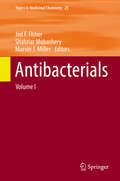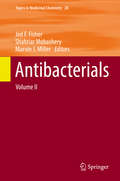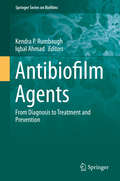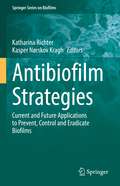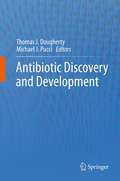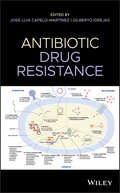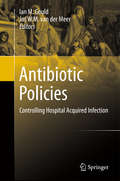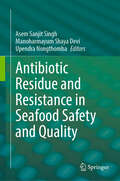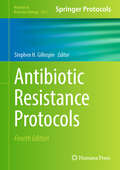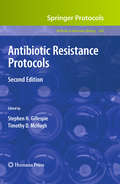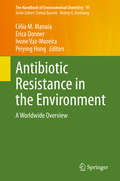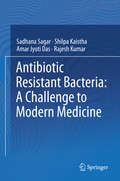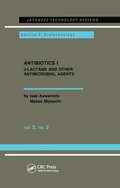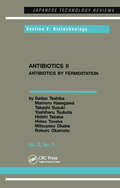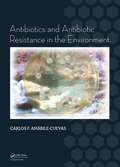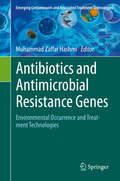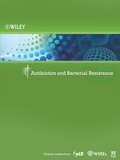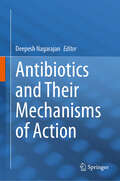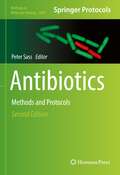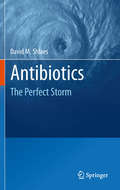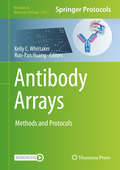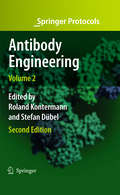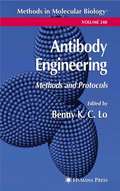- Table View
- List View
Antibacterial Peptide Protocols (Methods in Molecular Biology #78)
by William ShaferLeading experts review for the first time in one volume all the mjaor biochemical, molecular, bacteriological, and physical techniques available to assess antimicrobial peptides. These state-of-the-art methods ensure easily reproducible results in such important procedures as the isolation and characterization of antimicrobial peptides, the molecular characterization of genes encoding antimicrobial peptides, and the use of expression systems to isolate peptides. Bioassays and microbial genetic techniques are also included, as are antibacterial assays as the final readout system.
Antibacterial Surfaces
by Elena Ivanova Russell Crawford'Antibacterial Surfaces' covers the advances being made in the design of antibacterial surfaces, which have the ability to either prevent the initial attachment of bacterial cells, or kill any cells that come into contact with these surfaces. This book discusses the mechanisms associated with the attachment of bacteria to surfaces and the main strategies currently being employed to control the initial attachment processes. These strategies are expanded upon in the subsequent chapters, where the definition and description of antibacterial surfaces are clarified, as are the mechanisms that come into play when determining the effectiveness of an antibacterial surface. Subsequent chapters discuss a number of naturally occurring antibacterial surfaces, the methods currently being used for producing synthetic antibacterial surfaces, and the current and potential applications of such materials. This book will be of great interest to people who work with materials that need to remain free of bacterial films, from designing safer biomedical implants to the production of self-cleaning materials where the prevention of biofilm formation has significant economic advantages.
Antibacterials: Volume I (Topics in Medicinal Chemistry #25)
by Jed F. Fisher Shahriar Mobashery Marvin J. MillerMedicinal chemistry is both science and art. The science of medicinal chemistry offers mankind one of its best hopes for improving the quality of life. The art of medicinal chemistry continues to challenge its practitioners with the need for both intuition and experience to discover new drugs. Hence sharing the experience of drug research is uniquely beneficial to the field of medicinal chemistry. Drug research requires interdisciplinary team-work at the interface between chemistry, biology and medicine. Therefore, the topic-related series Topics in Medicinal Chemistry covers all relevant aspects of drug research, e.g. pathobiochemistry of diseases, identification and validation of (emerging) drug targets, structural biology, drugability of targets, drug design approaches, chemogenomics, synthetic chemistry including combinatorial methods, bioorganic chemistry, natural compounds, high-throughput screening, pharmacological in vitro and in vivo investigations, drug-receptor interactions on the molecular level, structure-activity relationships, drug absorption, distribution, metabolism, elimination, toxicology and pharmacogenomics. In general, special volumes are edited by well known guest editors
Antibacterials: Volume II (Topics in Medicinal Chemistry #26)
by Jed F. Fisher Shahriar Mobashery Marvin J. MillerMedicinal chemistry is both science and art. The science of medicinal chemistry offers mankind one of its best hopes for improving the quality of life. The art of medicinal chemistry continues to challenge its practitioners with the need for both intuition and experience to discover new drugs. Hence sharing the experience of drug research is uniquely beneficial to the field of medicinal chemistry. Drug research requires interdisciplinary team-work at the interface between chemistry, biology and medicine. Therefore, the topic-related series Topics in Medicinal Chemistry covers all relevant aspects of drug research, e.g. pathobiochemistry of diseases, identification and validation of (emerging) drug targets, structural biology, drugability of targets, drug design approaches, chemogenomics, synthetic chemistry including combinatorial methods, bioorganic chemistry, natural compounds, high-throughput screening, pharmacological in vitro and in vivo investigations, drug-receptor interactions on the molecular level, structure-activity relationships, drug absorption, distribution, metabolism, elimination, toxicology and pharmacogenomics. In general, special volumes are edited by well known guest editors
Antibiofilm Agents: From Diagnosis to Treatment and Prevention (Springer Series on Biofilms #8)
by Iqbal Ahmad Kendra P. RumbaughThis book provides a survey of recent advances in the development of antibiofilm agents for clinical and environmental applications. The fact that microbes exist in structured communities called biofilms has slowly become accepted within the medical community. We now know that over 80% of all infectious diseases are biofilm-related; however, significant challenges still lie in our ability to diagnose and treat these extremely recalcitrant infections. Written by experts from around the globe, this book offers a valuable resource for medical professionals seeking to treat biofilm-related disease, academic and industry researchers interested in drug discovery and instructors who teach courses on microbial pathogenesis and medical microbiology.
Antibiofilm Strategies: Current and Future Applications to Prevent, Control and Eradicate Biofilms (Springer Series on Biofilms #11)
by Katharina Richter Kasper Nørskov KraghBacteria and fungi are able to aggregate together or on surfaces in densely packed microcolonies, facilitated by extracellular polymeric substances for cell protection and stability. These biofilms have proven to be extremely hard to eradicate and remove once established. In chronic infections, this condition can result in a high degree of morbidity and mortality as regular antibiotic treatments are ineffective against biofilms. In industrial facilities, the formation of biofilms can ruin production and result in enormous financial losses. In this book, the current state of antibiofilm research is presented by experts from around the world. Novel, cutting-edge techniques and new optimized strategies based on established methods are discussed in chapters focused on biofilm prevention, treatment and control for the application in clinical, industrial and veterinary settings. Antibiofilm strategies, such as chemical and enzymatic treatments, surface modification and coatings, quorum sensing inhibition and dispersal induction, phage therapy, cold plasma treatment, hyperbaric oxygen treatment, and metal-based nanomedicine are covered, among many others. This book contributes to the UN’s Sustainable Development Goal 3: Good Health and Well-Being and is a valuable resource for healthcare professionals, microbiologists, academics and for educators to inform curricula of universities and colleges.
Antibiotic Discovery and Development
by Michael J. Pucci Thomas J. DoughertyThis volume covers all aspects of the antibiotic discovery and development process through Phase II/III. The contributors, a group of highly experienced individuals in both academics and industry, include chapters on the need for new antibiotic compounds, strategies for screening for new antibiotics, sources of novel synthetic and natural antibiotics, discovery phases of lead development and optimization, and candidate compound nominations into development. Beyond discovery , the handbook will cover all of the studies to prepare for IND submission: Phase I (safety and dose ranging), progression to Phase II (efficacy), and Phase III (capturing desired initial indications). This book walks the reader through all aspects of the process, which has never been done before in a single reference. With the rise of antibiotic resistance and the increasing view that a crisis may be looming in infectious diseases, there are strong signs of renewed emphasis in antibiotic research. The purpose of the handbook is to offer a detailed overview of all aspects of the problem posed by antibiotic discovery and development.
Antibiotic Drug Resistance
by José‐Luis Capelo‐Martínez Gilberto IgrejasThis book presents a thorough and authoritative overview of the multifaceted field of antibiotic science – offering guidance to translate research into tools for prevention, diagnosis, and treatment of infectious diseases. Provides readers with knowledge about the broad field of drug resistance Offers guidance to translate research into tools for prevention, diagnosis, and treatment of infectious diseases Links strategies to analyze microbes to the development of new drugs, socioeconomic impacts to therapeutic strategies, and public policies to antibiotic-resistance-prevention strategies
Antibiotic Policies: Controlling Hospital Acquired Infection
by Ian M. Gould Jos W.M. MeerThe first book was on "Theory and Practice" of antibiotic stewardship in its broadest sense -the how to do it and the do's and don'ts. The second, on "Controlling resistance" was very much on the relationships between use and resistance and beginning to home in on the hospital as the main generator of resistance, but mainly looking at it from a disease/clinical perspective. The last 3 chapters on MRSA, ended where the 3rd book will take off. "Controlling HAI " will concentrate on specific MDR organisms highlighting their roles in the current pandemic of HAI and emphasizing that the big issue is not so much infection control but antibiotic control, in the same way that antibiotic over-reliance/ over-use has caused the problem in the first place. Up 'till now the emphasis for controlling MRSA, C diff and all the other MDROs has very much been on IC, which clearly isn't working. This book will gather all the evidence for the increasingly popular view that much more must be done in the area of antibiotic policies/ stewardship, especially when we are in danger of a "post antibiotic" era, due to a real shortage of new agents in the pipeline.
Antibiotic Residue and Resistance in Seafood Safety and Quality
by Asem Sanjit Singh Manoharmayum Shaya Devi Upendra NongthombaThis book embark explores the global antibiotic trends in seafood, and delves into the intricate interplay between antibiotic consumption and its ramifications within the seafood industry. The nuanced effects of processing techniques on antibiotic residue levels in seafood are investigated, elucidating the prevalence of antibiotics and their metabolites within these commodities. The book also peers into the microbial realm of seafood, revealing the intricacies of resistance mechanisms, prevalence rates, pathogenicity, and related phenomena. It then explores the antibiotic alternatives in aquatic environments, including the utilization of nanoparticles and plant extracts. Artificial intelligence integration and sensor development for antibiotic residue detection ensures quality assurance and consumer safety within the seafood industry, and has been well-covered in this volume. This edited volume is beneficial for graduate students in fisheries science, life sciences, animal biotechnology, zoology, and microbiology. This can be a reference material for fisheries professionals, scientific communities, researchers, and scholars as well, for navigating the global antibiotic trends in seafood.
Antibiotic Resistance Protocols: Second Edition (Methods in Molecular Biology #2833)
by Stephen H. GillespieThis fully updated edition explores current techniques for research into antibiotic resistance. The book begins with how samples are collected, strains isolated and sequenced, and the results integrated in the microbiological workflow. It continues with novel methods to test resistance and interactions between antibiotics, physiological conditions, or using innovative tools like the hollow fiber or Raman spectroscopy, as well as mathematical models that can describe resistance within host. Written for the highly successful Methods in Molecular Biology series, chapters include introductions to their respective topics, lists of the necessary materials and reagents, step-by-step and readily reproducible laboratory protocols, and tips on troubleshooting and avoiding known pitfalls. Authoritative and up-to-date, Antibiotic Resistance Protocols, Fourth Edition serves as an ideal guide for answering questions on how to control antibiotic resistance, to develop new agents, and to address the problems posed by microbes that have become resistant to our antibiotics.
Antibiotic Resistance Protocols: Second Edition (Methods in Molecular Biology #642)
by Stephen H. Gillespie Timothy D. MchughSince the publication of the popular first edition, genomic methods have become more accessible, allowing antibiotic researchers to probe not only the sequence of antibiotic resistance determinants but the mechanism whereby they are expressed and regulated. That, in concert with array technology and an understanding of the importance of biofilms, has greatly expanded antibiotic resistance knowledge. In order to reflect the growing field, Antibiotic Resistance Protocols, Second Edition fully updates and builds upon its first edition with contributions from leading researchers. Beginning with chapters on epidemiology and population genetics, the book continues with sections covering genomics and gene expressions, fitness mutation and physiology, and the detection of resistance. Written in the highly successful Methods in Molecular BiologyTM series format, chapters include introductions to their respective topics, lists of the necessary materials and reagents, step-by-step, readily reproducible laboratory protocols, and notes on troubleshooting and avoiding known pitfalls. Authoritative and up-to-date, Antibiotic Resistance Protocols, Second Edition brings together examples of a diverse range of modern techniques applied in antibiotic research in order to best aid scientists in planning their own future research.
Antibiotic Resistance in the Environment: A Worldwide Overview (The Handbook of Environmental Chemistry #91)
by Célia M. Manaia Erica Donner Ivone Vaz-Moreira Peiying HongThis book provides a multidisciplinary review of antibiotic resistance and unravels the complex and interrelated roles of environmental sources, including pharmaceutical industry effluents, hospital and domestic effluents, wildlife and drinking water. Antibiotic resistance is a global public health issue in which the interface between humans, animals and the environment is particularly relevant. The contrasts seen across different environmental compartments and world regions, which are due to climate, social and policy differences, mean that this problem needs to be analyzed from a multi-geographic and multi-cultural angle. Bringing together contributions from researchers on different continents with expertise in antibiotic resistance in a range of different environmental compartments, the book offers a detailed reflection on the paths that make antibiotic resistance a global threat, and the state-of- the-art in antibiotic resistance surveillance and risk assessment in complex environmental matrices.
Antibiotic Resistant Bacteria: A Challenge to Modern Medicine
by Rajesh Kumar Amar Jyoti Das Sadhana Sagar Shilpa KaisthaThis book summarizes the emerging trends in the field of antibiotic resistance of various gram-negative and gram-positive bacterial species. The ability of different species of bacteria to resist the antimicrobial agent has become a global problem. As such, the book provides a comprehensive overview of the advances in our understanding of the origin and mechanism of resistance, discusses the modern concept of the biochemical and genetic basis of antibacterial resistance and highlights the clinical and economic implications of the increased prevalence of antimicrobial resistant pathogens and their ecotoxic effects. It also reviews various strategies to curtail the emergence and examines a number of innovative therapeutic approaches, such as CRISPR, phage therapy, nanoparticles and natural antimicrobials, to combat the spread of resistance.
Antibiotics I
by Isao KawamotoThis book reviews more recent studies of antibiotics in Japan. It describes β-lactams and other antimicrobial agents according to the following categories: parenteral cephems and related compounds, oral cephalosporins, penems and carbapenems, monobactams, aminoglycosides, and macrolides.
Antibiotics II
by Sadao TeshibaThis book reviews more recent studies of antibiotics in Japan. It covers astromicin, application of cyclodextrin in the fermentative production process, production of Bialaphos from a Biochemical Engineering viewpoint, and acyl derivatives of tylosin produced by microbial transformation.
Antibiotics and Antibiotic Resistance in the Environment
by Carlos F. Amabile-CuevasThe presence of antibiotics, antibiotic resistance genes, and antibiotic resistant bacteria in the environment is a cause of growing worldwide concern, as it reveals the extensive impact of antibiotic abuse and other human-related pressures upon microbes. The field of detecting and measuring resistance in the environment has rapidly evolved to a systematic search of organisms and genes. This book will review the available evidence and hypotheses on where antibiotic resistance is coming from and for how long it has been there. Further, it will discuss involved maintenance pressures, resistance spread, traits and laboratory and in-silico strategies to further investigate antibiotic resistance.
Antibiotics and Antimicrobial Resistance Genes: Environmental Occurrence and Treatment Technologies (Emerging Contaminants and Associated Treatment Technologies)
by Muhammad Zaffar HashmiThis volume summarizes and updates information about antibiotics and antimicrobial resistance (AMR)/antibiotic resistant genes (ARG) production, including their entry routes in soil, air, water and sediment, their use in hospital and associated waste, global and temporal trends in use and spread of antibiotics, AMR and ARG. Antimicrobial/antibiotic resistance genes due to manure and agricultural waste applications, bioavailability, biomonitoring, and their Epidemiological, ecological and public health effects. The book addresses the antibiotic and AMR/ARG risk assessment and treatment technologies, for managing antibiotics and AMR/ARG impacted environments The book's expert contributions span 20 chapters, and offer a comprehensive framework for better understanding and analyzing the environmental and social impacts of antibiotics and AMR/ARGs. Readers will have access to recent and updated models regarding the interpretation of antibiotics and AMR/ARGs in environment and biomonitoring studies, and will learn about the management options require to appropriately mitigate environmental contaminants and pollution. The book will be of interest to students, teachers, researchers, policy makers and environmental organizations.
Antibiotics and Bacterial Resistance (Life Science Research Fundamentals)
by WileyThe need for novel antibiotics is greater now than perhaps any time since the pre-antibiotic era. Indeed, the recent collapse of many pharmaceutical antibacterial groups, combined with the emergence of hypervirulent and pan-antibiotic-resistant bacteria has severely compromised infection treatment options and led to dramatic increases in the incidence and severity of bacterial infections. This collection of reviews and laboratory protocols gives the reader an introduction to the causes of antibiotic resistance, the bacterial strains that pose the largest danger to humans (i.e., streptococci, pneumococci and enterococci) and the antimicrobial agents used to combat infections with these organisms. Some new avenues that are being investigated for antibiotic development are also discussed. Such developments include the discovery of agents that inhibit bacterial RNA degradation, the bacterial ribosome, and structure-based approaches to antibiotic drug discovery. Two laboratory protocols are provided to illustrate different strategies for discovering new antibiotics. One is a bacterial growth inhibition assay to identify inhibitors of bacterial growth that specifically target conditionally essential enzymes in the pathway of interest. The other protocol is used to identify inhibitors of bacterial cell-to-cell signaling. This e-book — a curated collection from eLS, WIREs, and Current Protocols — offers a fantastic introduction to the field of antibiotics and antibiotic resistance for students or interdisciplinary collaborators.
Antibiotics and Their Mechanisms of Action
by Deepesh Nagarajan“Antibiotics and their mechanisms of action” provides a deep and lucid understanding of the mechanisms of action of various antibiotics. The experiments followed to decipher the mechanisms have been explained in great depth, which is a novelty in this textbook. Most undergraduate textbooks on antibiotics place emphasis on their use from the clinician’s perspective. Taking penicillin as an example, typical textbooks discuss its discovery, penicillin’s β-lactam derivatives, routes of administration, the diseases and pathogens treated with β-lactam antibiotics, side effects, and finally the mechanisms of resistance that have evolved against penicillin. No description of how its mechanism of action was deciphered is ever provided. This textbook describes how simple experiments using protoplasts, covalent affinity chromatography, SYPRO Orange binding assays, and X-ray crystallography have all been used to elucidate the mechanism of action of penicillin. Like this, the complicated mechanisms of action of different antibiotics have been presented in simple terms with the help of original illustrations. Chapters 8-10 cover the mechanisms of action of anti-ribosomal antibiotics (tetracycline, streptomycin, chloramphenicol). Elucidating the mechanisms of action for these antibiotics requires complex experiments such as ex vivo transcription via a cell-free ribosomal reaction mixture, photolabelling experiments, and sucrose density gradient centrifugation of radiolabelled translation reactants and products. These experiments are conveyed to the reader in the simplest possible language and with easily understandable, appealing illustrations. Finally, the reader is challenged at the end of every chapter with original questions, testing whether hecan apply the concepts he learned in the preceding chapter to research-level problems. This book is written primarily for undergraduate students in microbiology or biotechnology courses to help them develop a simplistic yet comprehensive understanding of the mechanisms underlying antibiotics action. It is believed that this book will prepare the students for PhD level research.
Antibiotics: Methods and Protocols (Methods in Molecular Biology #2601)
by Peter SassThis second edition provides state-of-the-art and novel methods on antibiotic isolation and purification, identification of antimicrobial killing mechanisms, as well as methods for the analysis and detection of microbial responses and adaptation strategies. Antibiotics: Methods and Protocols, Second Edition, guides readers through updated and entirely new chapters on production and design, mode of action, and response and resistance. Written in the highly successful Methods in Molecular Biology series format, chapters include introductions to their respective topics, lists of the necessary materials and reagents, step-by-step, readily reproducible laboratory protocols, and tips on troubleshooting and avoiding known pitfalls. Authoritative and cutting-edge, Antibiotics: Methods and Protocols, Second Edition aims to inspire scientific work in the exciting field of antibiotic research.
Antibiotics: The Perfect Storm
by David M. ShlaesAntibiotics are truly miracle drugs. As a class, they are one of the only ones that actually cure disease as opposed to most drugs that only help relieve symptoms or control disease. Since bacteria that cause serious disease in humans are becoming more and more resistant to the antibiotics we have today, and because they will ultimately become resistant to any antibiotic that we use for treatment or for anything else, we need a steady supply of new antibiotics active against any resistant bacteria that arise. However, the antibiotics marketplace is no longer attractive for large pharmaceutical companies, the costs of development are skyrocketing because of ever more stringent requirements by the regulatory agencies, and finding new antibiotics active against resistant strains is getting harder and harder. These forces are all combining to deny us these miracle drugs when we need them the most. I provide a number of possible paths to shelter from this perfect storm.
Antibody Arrays: Methods and Protocols (Methods in Molecular Biology #2237)
by Kelly C. Whittaker Ruo-Pan HuangThis detailed book presents a technical overview and practical methodology of a variety of antibody array formats and technologies. As advantages and disadvantages of antibody array types are explored, the volume also delves into practical applications of antibody arrays pertaining to investigations of specific research topics and biological processes as well as guidance on the methods of processing, analysis, and storage of array data. Written for the highly successful Methods in Molecular Biology series, chapters include introductions to their respective topics, lists of the necessary materials and reagents, step-by-step, readily reproducible laboratory protocols, and tips on troubleshooting and avoiding known pitfalls. Authoritative and cutting-edge, Antibody Arrays: Methods and Protocols aims to empower the reader with the information required to select the most appropriate array for their research application, with the technical knowledge to use and process the array, and with the knowledge to perform analysis that realizes the maximum benefit from the data generated.
Antibody Engineering Volume 1 (Springer Laboratory Manual Ser.)
by Roland E. Kontermann Stefan DübelAntibodies are indispensable tools for research, diagnosis, and therapy. Recombinant approaches allow the modification and improvement of nearly all antibody properties, such as affinity, valency, specificity, stability, serum half-life, effector functions, and immunogenicity. "Antibody Engineering" provides a comprehensive toolbox covering the well-established basics but also many exciting new techniques. The protocols reflect the latest "hands on" knowledge of key laboratories in this still fast-moving field. Newcomers will benefit from the proven step-by-step protocols, which include helpful practical advice; experienced antibody engineers will appreciate the new ideas and approaches. The book is an invaluable resource for all those engaged in antibody research and development.
Antibody Engineering: Methods and Protocols (Methods in Molecular Biology #248)
by Benny K. LoA core collection of diverse cutting-edge techniques for the generation, expression, optimization, and characterization of recombinant antibodies. Readily reproducible protocols for lead generation range from the cloning of human immunoglobulin genes to the selection and generation of human recombinant antibodies by humanization approaches, molecular display technologies and transgenic animals. Procedures are also described on restructuring antibody leads into monovalent, multivalent, and bispecific binding fragments for a wide variety of in vivo applications. State-of-the-art technologies are described for the characterization of antigen-binding affinity and specificity with novel applications in radioimmunotargeting, cancer immunotherapy, drug abuse, and proteomics.
